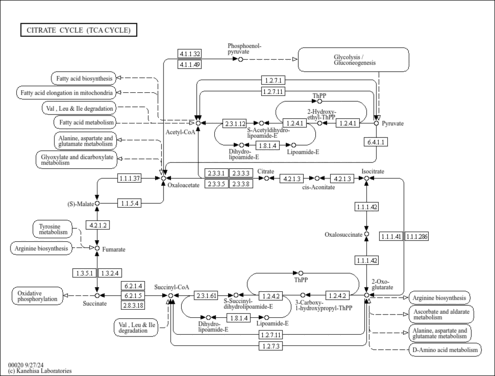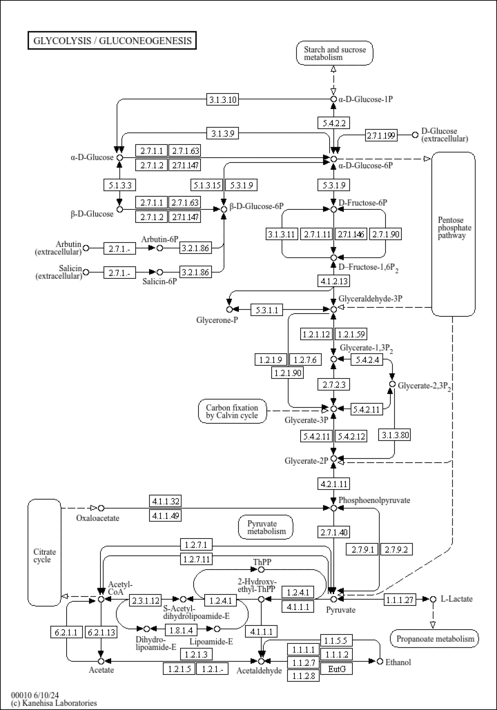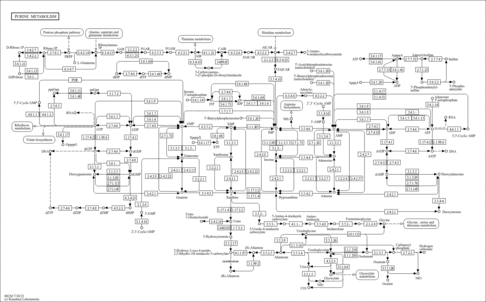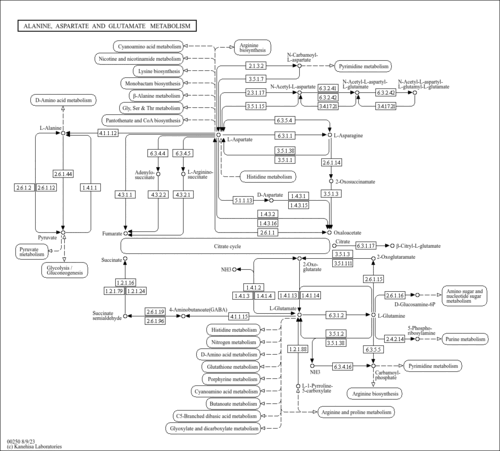| Record Information |
|---|
| Version | 1.0 |
|---|
| Created at | 2020-04-17 19:08:49 UTC |
|---|
| Updated at | 2020-12-07 19:11:34 UTC |
|---|
| CannabisDB ID | CDB005095 |
|---|
| Secondary Accession Numbers | Not Available |
|---|
| Cannabis Compound Identification |
|---|
| Common Name | Guanosine diphosphate |
|---|
| Description | Guanosine diphosphate, also known as 5'-GDP or 5'-diphosphate, guanosine, belongs to the class of organic compounds known as purine ribonucleoside diphosphates. These are purine ribobucleotides with diphosphate group linked to the ribose moiety. Guanosine diphosphate is a moderately basic compound (based on its pKa). Guanosine diphosphate exists in all living species, ranging from bacteria to humans. In humans, guanosine diphosphate is involved in intracellular signalling through adenosine receptor A2B and adenosine. Outside of the human body, Guanosine diphosphate has been detected, but not quantified in, several different foods, such as devilfish, java plums, green beans, almonds, and orange mints. This could make guanosine diphosphate a potential biomarker for the consumption of these foods. A purine ribonucleoside 5'-diphosphate resulting from the formal condensation of the hydroxy group at the 5' position of guanosine with pyrophosphoric acid. Guanosine diphosphate is expected to be in Cannabis as all living plants are known to produce and metabolize it. |
|---|
| Structure | |
|---|
| Synonyms | | Value | Source |
|---|
| Guanosine 5'-diphosphate | ChEBI | | Guanosine 5'-diphosphoric acid | Generator | | Guanosine diphosphoric acid | Generator | | 5'-GDP | HMDB | | GDP | HMDB | | Guanosine 5'-(trihydrogen pyrophosphate) | HMDB | | Guanosine 5'-pyrophosphate | HMDB | | Guanosine mono(trihydrogen diphosphate) | HMDB | | Guanosine pyrophosphate | HMDB | | Guanosine-5'-diphosphate | HMDB | | Guanosine-diphosphate | HMDB | | PpG | HMDB | | 5'-Diphosphate, guanosine | HMDB | | Diphosphate, guanosine 5'-trihydrogen | HMDB | | Guanosine 5' diphosphate | HMDB | | Guanosine 5' trihydrogen diphosphate | HMDB | | 5'-Trihydrogen diphosphate, guanosine | HMDB | | Diphosphate, guanosine | HMDB | | Guanosine 5'-trihydrogen diphosphate | HMDB |
|
|---|
| Chemical Formula | C10H15N5O11P2 |
|---|
| Average Molecular Weight | 443.2 |
|---|
| Monoisotopic Molecular Weight | 443.0243 |
|---|
| IUPAC Name | [({[(2R,3S,4R,5R)-5-(2-amino-6-oxo-6,9-dihydro-3H-purin-9-yl)-3,4-dihydroxyoxolan-2-yl]methoxy}(hydroxy)phosphoryl)oxy]phosphonic acid |
|---|
| Traditional Name | {[(2R,3S,4R,5R)-5-(2-amino-6-oxo-3H-purin-9-yl)-3,4-dihydroxyoxolan-2-yl]methoxy(hydroxy)phosphoryl}oxyphosphonic acid |
|---|
| CAS Registry Number | 146-91-8 |
|---|
| SMILES | NC1=NC2=C(N=CN2[C@@H]2O[C@H](COP(O)(=O)OP(O)(O)=O)[C@@H](O)[C@H]2O)C(=O)N1 |
|---|
| InChI Identifier | InChI=1S/C10H15N5O11P2/c11-10-13-7-4(8(18)14-10)12-2-15(7)9-6(17)5(16)3(25-9)1-24-28(22,23)26-27(19,20)21/h2-3,5-6,9,16-17H,1H2,(H,22,23)(H2,19,20,21)(H3,11,13,14,18)/t3-,5-,6-,9-/m1/s1 |
|---|
| InChI Key | QGWNDRXFNXRZMB-UUOKFMHZSA-N |
|---|
| Chemical Taxonomy |
|---|
| Description | Belongs to the class of organic compounds known as purine ribonucleoside diphosphates. These are purine ribobucleotides with diphosphate group linked to the ribose moiety. |
|---|
| Kingdom | Organic compounds |
|---|
| Super Class | Nucleosides, nucleotides, and analogues |
|---|
| Class | Purine nucleotides |
|---|
| Sub Class | Purine ribonucleotides |
|---|
| Direct Parent | Purine ribonucleoside diphosphates |
|---|
| Alternative Parents | |
|---|
| Substituents | - Purine ribonucleoside diphosphate
- Purine ribonucleoside monophosphate
- Pentose phosphate
- Pentose-5-phosphate
- Glycosyl compound
- N-glycosyl compound
- 6-oxopurine
- Hypoxanthine
- Monosaccharide phosphate
- Organic pyrophosphate
- Pentose monosaccharide
- Imidazopyrimidine
- Purine
- Aminopyrimidine
- Monoalkyl phosphate
- Pyrimidone
- Monosaccharide
- N-substituted imidazole
- Organic phosphoric acid derivative
- Alkyl phosphate
- Phosphoric acid ester
- Pyrimidine
- Vinylogous amide
- Tetrahydrofuran
- Azole
- Imidazole
- Heteroaromatic compound
- Secondary alcohol
- 1,2-diol
- Organoheterocyclic compound
- Azacycle
- Oxacycle
- Organooxygen compound
- Organic nitrogen compound
- Hydrocarbon derivative
- Organic oxide
- Organopnictogen compound
- Alcohol
- Amine
- Organic oxygen compound
- Primary amine
- Organonitrogen compound
- Aromatic heteropolycyclic compound
|
|---|
| Molecular Framework | Aromatic heteropolycyclic compounds |
|---|
| External Descriptors | |
|---|
| Ontology |
|---|
|
| Physiological effect | Health effect: |
|---|
| Disposition | Route of exposure: Source: Biological location: |
|---|
| Role | Industrial application: |
|---|
| Physical Properties |
|---|
| State | Solid |
|---|
| Experimental Properties | | Property | Value | Reference |
|---|
| Melting Point | Not Available | Not Available | | Boiling Point | Not Available | Not Available | | Water Solubility | Not Available | Not Available | | logP | Not Available | Not Available |
|
|---|
| Predicted Properties | [] |
|---|
| Spectra |
|---|
| EI-MS/GC-MS | | Type | Description | Splash Key | View |
|---|
| Predicted GC-MS | Guanosine diphosphate, non-derivatized, Predicted GC-MS Spectrum - 70eV, Positive | splash10-004i-5930200000-bdc0893316c12636a495 | Spectrum | | Predicted GC-MS | Guanosine diphosphate, 2 TMS, Predicted GC-MS Spectrum - 70eV, Positive | splash10-0229-6393250000-a57b7f18975223fa888c | Spectrum | | Predicted GC-MS | Guanosine diphosphate, non-derivatized, Predicted GC-MS Spectrum - 70eV, Positive | Not Available | Spectrum |
|
|---|
| MS/MS | | Type | Description | Splash Key | View |
|---|
| MS/MS | LC-MS/MS Spectrum - Quattro_QQQ 10V, Positive (Annotated) | splash10-0udl-0900600000-5c7173a5771dfefadc5e | 2012-07-24 | View Spectrum | | MS/MS | LC-MS/MS Spectrum - Quattro_QQQ 25V, Positive (Annotated) | splash10-0udi-0900000000-d38af29994fa5108c331 | 2012-07-24 | View Spectrum | | MS/MS | LC-MS/MS Spectrum - Quattro_QQQ 40V, Positive (Annotated) | splash10-0udi-0900000000-3072d857dcc8a1b2cbaa | 2012-07-24 | View Spectrum | | MS/MS | LC-MS/MS Spectrum - , negative | splash10-0kdi-5901100000-24a5c807e53370f01d0c | 2017-09-14 | View Spectrum | | MS/MS | LC-MS/MS Spectrum - , positive | splash10-0udi-0900000000-6399eaf97235815c4cb7 | 2017-09-14 | View Spectrum | | MS/MS | LC-MS/MS Spectrum - 35V, Positive | splash10-0udi-0900000000-80f8e0b42526cc03fef4 | 2021-09-20 | View Spectrum | | MS/MS | LC-MS/MS Spectrum - 30V, Negative | splash10-0pdl-2902100000-027fb059218f84756c35 | 2021-09-20 | View Spectrum | | MS/MS | LC-MS/MS Spectrum - 30V, Negative | splash10-0pdl-2902200000-876f01fe6b2be177ac75 | 2021-09-20 | View Spectrum | | MS/MS | LC-MS/MS Spectrum - 30V, Negative | splash10-0pdl-3902100000-054557b6d17ed830f7e5 | 2021-09-20 | View Spectrum | | MS/MS | LC-MS/MS Spectrum - 40V, Negative | splash10-004i-9600000000-2f85040f9b280383ec8a | 2021-09-20 | View Spectrum | | MS/MS | LC-MS/MS Spectrum - 20V, Negative | splash10-054o-5904800000-e39f64dcf91afa144498 | 2021-09-20 | View Spectrum | | MS/MS | LC-MS/MS Spectrum - 10V, Negative | splash10-0006-0001900000-cdce5e7d8986462632b2 | 2021-09-20 | View Spectrum | | MS/MS | LC-MS/MS Spectrum - 35V, Negative | splash10-0kdi-5901100000-ba4bded631640c110a56 | 2021-09-20 | View Spectrum | | Predicted MS/MS | Predicted LC-MS/MS Spectrum - 10V, Positive | splash10-0udi-0911300000-fcd49d8a5e9d3dc3f933 | 2016-09-12 | View Spectrum | | Predicted MS/MS | Predicted LC-MS/MS Spectrum - 20V, Positive | splash10-0udi-0900000000-ded96f0f499982ac1ab0 | 2016-09-12 | View Spectrum | | Predicted MS/MS | Predicted LC-MS/MS Spectrum - 40V, Positive | splash10-0udi-0900000000-ac93e95f54842f42e273 | 2016-09-12 | View Spectrum | | Predicted MS/MS | Predicted LC-MS/MS Spectrum - 10V, Negative | splash10-0f6x-0900800000-1ed1199fdace4d1b4d80 | 2016-09-12 | View Spectrum | | Predicted MS/MS | Predicted LC-MS/MS Spectrum - 20V, Negative | splash10-0zir-3900000000-b9aeef613c34fe99a48c | 2016-09-12 | View Spectrum | | Predicted MS/MS | Predicted LC-MS/MS Spectrum - 40V, Negative | splash10-004i-9200000000-f630c9237e72a76d3d63 | 2016-09-12 | View Spectrum | | Predicted MS/MS | Predicted LC-MS/MS Spectrum - 10V, Positive | splash10-0udi-0900200000-fa2d42f6050d9ab60119 | 2021-09-22 | View Spectrum | | Predicted MS/MS | Predicted LC-MS/MS Spectrum - 20V, Positive | splash10-0udi-0900000000-ed3d09503a04c850d595 | 2021-09-22 | View Spectrum | | Predicted MS/MS | Predicted LC-MS/MS Spectrum - 40V, Positive | splash10-0udi-0900000000-19a5699334c495daa4e5 | 2021-09-22 | View Spectrum | | Predicted MS/MS | Predicted LC-MS/MS Spectrum - 10V, Negative | splash10-0006-0001900000-7b9b9276c5e39c703f8c | 2021-09-23 | View Spectrum | | Predicted MS/MS | Predicted LC-MS/MS Spectrum - 20V, Negative | splash10-004i-9202300000-fa0fbdc8c265ee49a371 | 2021-09-23 | View Spectrum | | Predicted MS/MS | Predicted LC-MS/MS Spectrum - 40V, Negative | splash10-004i-9100000000-278ab542160fff840256 | 2021-09-23 | View Spectrum |
|
|---|
| NMR | | Type | Description | | View |
|---|
| 1D NMR | 1H NMR Spectrum (1D, 500 MHz, H2O, experimental) | | Spectrum | | 1D NMR | 1H NMR Spectrum (1D, D2O, experimental) | | Spectrum | | 1D NMR | 13C NMR Spectrum (1D, D2O, experimental) | | Spectrum | | 1D NMR | 13C NMR Spectrum (1D, 100 MHz, D2O, predicted) | | Spectrum | | 1D NMR | 1H NMR Spectrum (1D, 100 MHz, D2O, predicted) | | Spectrum | | 1D NMR | 13C NMR Spectrum (1D, 1000 MHz, D2O, predicted) | | Spectrum | | 1D NMR | 1H NMR Spectrum (1D, 1000 MHz, D2O, predicted) | | Spectrum | | 1D NMR | 13C NMR Spectrum (1D, 200 MHz, D2O, predicted) | | Spectrum | | 1D NMR | 1H NMR Spectrum (1D, 200 MHz, D2O, predicted) | | Spectrum | | 1D NMR | 13C NMR Spectrum (1D, 300 MHz, D2O, predicted) | | Spectrum | | 1D NMR | 1H NMR Spectrum (1D, 300 MHz, D2O, predicted) | | Spectrum | | 1D NMR | 13C NMR Spectrum (1D, 400 MHz, D2O, predicted) | | Spectrum | | 1D NMR | 1H NMR Spectrum (1D, 400 MHz, D2O, predicted) | | Spectrum | | 1D NMR | 13C NMR Spectrum (1D, 500 MHz, D2O, predicted) | | Spectrum | | 1D NMR | 1H NMR Spectrum (1D, 500 MHz, D2O, predicted) | | Spectrum | | 1D NMR | 13C NMR Spectrum (1D, 600 MHz, D2O, predicted) | | Spectrum | | 1D NMR | 1H NMR Spectrum (1D, 600 MHz, D2O, predicted) | | Spectrum | | 1D NMR | 13C NMR Spectrum (1D, 700 MHz, D2O, predicted) | | Spectrum | | 1D NMR | 1H NMR Spectrum (1D, 700 MHz, D2O, predicted) | | Spectrum | | 1D NMR | 13C NMR Spectrum (1D, 800 MHz, D2O, predicted) | | Spectrum | | 1D NMR | 1H NMR Spectrum (1D, 800 MHz, D2O, predicted) | | Spectrum | | 1D NMR | 13C NMR Spectrum (1D, 900 MHz, D2O, predicted) | | Spectrum | | 1D NMR | 1H NMR Spectrum (1D, 900 MHz, D2O, predicted) | | Spectrum | | 2D NMR | [1H, 1H]-TOCSY. Unexported temporarily by An Chi on Oct 15, 2021 until json or nmrML file is generated. 2D NMR Spectrum (experimental) | | Spectrum | | 2D NMR | [1H, 13C]-HSQC NMR Spectrum (2D, 600 MHz, H2O, experimental) | | Spectrum |
|
|---|
| Pathways |
|---|
| Pathways | | Name | SMPDB/Pathwhiz | KEGG | | Citric Acid Cycle |    |  | | Gluconeogenesis |    |  | | Purine Metabolism |    |  | | Aspartate Metabolism |    |  | | Canavan Disease |    | Not Available |
|
|---|
| Protein Targets |
|---|
| Enzymes | |
| Ectonucleoside triphosphate diphosphohydrolase 1 | ENTPD1 | 10q24 | P49961 | details | | Soluble calcium-activated nucleotidase 1 | CANT1 | 17q25.3 | Q8WVQ1 | details | | Ectonucleoside triphosphate diphosphohydrolase 3 | ENTPD3 | 3p21.3 | O75355 | details | | Uridine-cytidine kinase 1 | UCK1 | 9q34.13 | Q9HA47 | details | | Nucleoside diphosphate kinase, mitochondrial | NME4 | 16p13.3 | O00746 | details | | Ribonucleoside-diphosphate reductase large subunit | RRM1 | 11p15.5 | P23921 | details | | Nucleoside diphosphate kinase A | NME1 | 17q21.3 | P15531 | details | | Nucleoside diphosphate kinase 7 | NME7 | 1q24 | Q9Y5B8 | details | | Ribonucleoside-diphosphate reductase subunit M2 | RRM2 | 2p25-p24 | P31350 | details | | Nucleoside diphosphate kinase B | NME2 | 17q21.3 | P22392 | details | | Nucleoside diphosphate kinase 3 | NME3 | 16q13.3 | Q13232 | details | | Nucleoside diphosphate kinase 6 | NME6 | 3p21 | O75414 | details | | Fucose-1-phosphate guanylyltransferase | FPGT | 1p31.1 | O14772 | details | | Alpha-1,3/1,6-mannosyltransferase ALG2 | ALG2 | 9q22.33 | Q9H553 | details | | Dolichol-phosphate mannosyltransferase | DPM1 | 20q13.13 | O60762 | details | | GDP-mannose 4,6 dehydratase | GMDS | 6p25 | O60547 | details | | Galactoside 2-alpha-L-fucosyltransferase 2 | FUT2 | 19q13.3 | Q10981 | details | | Galactoside 2-alpha-L-fucosyltransferase 1 | FUT1 | 19q13.3 | P19526 | details | | 6-phosphofructokinase type C | PFKP | 10p15.3-p15.2 | Q01813 | details | | 6-phosphofructokinase, liver type | PFKL | 21q22.3 | P17858 | details | | 6-phosphofructokinase, muscle type | PFKM | 12q13.3 | P08237 | details | | Pyruvate kinase isozymes M1/M2 | PKM | 15q22 | P14618 | details | | Pyruvate kinase isozymes R/L | PKLR | 1q21 | P30613 | details | | Ectonucleoside triphosphate diphosphohydrolase 4 | ENTPD4 | 8p21.3 | Q9Y227 | details | | Ectonucleoside triphosphate diphosphohydrolase 6 | ENTPD6 | 20p11.21 | O75354 | details | | Ectonucleoside triphosphate diphosphohydrolase 5 | ENTPD5 | 14q24 | O75356 | details | | Adenylosuccinate synthetase isozyme 2 | ADSS | 1q44 | P30520 | details | | Adenylosuccinate synthetase isozyme 1 | ADSSL1 | 14q32.33 | Q8N142 | details | | Succinyl-CoA ligase [ADP/GDP-forming] subunit alpha, mitochondrial | SUCLG1 | 2p11.2 | P53597 | details | | Phosphoenolpyruvate carboxykinase [GTP], mitochondrial | PCK2 | 14q11.2 | Q16822 | details | | Succinyl-CoA ligase [GDP-forming] subunit beta, mitochondrial | SUCLG2 | 3p14.1 | Q96I99 | details | | Phosphoenolpyruvate carboxykinase, cytosolic [GTP] | PCK1 | 20q13.31 | P35558 | details | | GDP-L-fucose synthase | TSTA3 | 8q24.3 | Q13630 | details | | Guanylate kinase | GUK1 | 1q32-q41 | Q16774 | details | | Succinyl-CoA ligase [ADP-forming] subunit beta, mitochondrial | SUCLA2 | 13q12.2-q13.3 | Q9P2R7 | details | | Alpha-(1,3)-fucosyltransferase | FUT5 | 19p13.3 | Q11128 | details | | Polyribonucleotide nucleotidyltransferase 1, mitochondrial | PNPT1 | 2p15 | Q8TCS8 | details | | Rho guanine nucleotide exchange factor 1 | ARHGEF1 | 19q13.13 | Q92888 | details | | Guanine nucleotide-binding protein G(s) subunit alpha isoforms short | GNAS | 20q13.3 | P63092 | details | | Vinexin | SORBS3 | 8p21.3 | O60504 | details | | GTPase HRas | HRAS | 11p15.5 | P01112 | details | | Guanine nucleotide-binding protein G(q) subunit alpha | GNAQ | 9q21 | P50148 | details | | Guanine nucleotide-binding protein subunit alpha-11 | GNA11 | 19p13.3 | P29992 | details | | Chitobiosyldiphosphodolichol beta-mannosyltransferase | ALG1 | 16p13.3 | Q9BT22 | details | | Guanine nucleotide-binding protein G(t) subunit alpha-1 | GNAT1 | 3p21 | P11488 | details | | Uridine-cytidine kinase 2 | UCK2 | 1q23 | Q9BZX2 | details | | Protein ALEX | GNAS | 20q13.3 | P84996 | details | | Lysophosphatidic acid receptor 2 | LPAR2 | 19p12 | Q9HBW0 | details | | ENTPD4 protein | ENTPD4 | 8p21.3 | Q8NE73 | details | | Mannose-1-phosphate guanyltransferase beta | GMPPB | 3p21.31 | Q9Y5P6 | details | | Mannose-1-phosphate guanyltransferase alpha | GMPPA | 2q35 | Q96IJ6 | details | | Alpha-(1,6)-fucosyltransferase | FUT8 | 14q24.3 | Q9BYC5 | details | | Ribonucleoside-diphosphate reductase subunit M2 B | RRM2B | 8q23.1 | Q7LG56 | details | | Uridine-cytidine kinase-like 1 | UCKL1 | 20q13.33 | Q9NWZ5 | details | | Ectonucleoside triphosphate diphosphohydrolase 8 | ENTPD8 | 9q34.3 | Q5MY95 | details | | GTPase-activating protein and VPS9 domain-containing protein 1 | GAPVD1 | 9q33.3 | Q14C86 | details | | Probable E3 ubiquitin-protein ligase HERC1 | HERC1 | 15q22 | Q15751 | details | | Interferon-inducible GTPase 5 | IRGC | 19q13.31 | Q6NXR0 | details | | MAP kinase-activating death domain protein | MADD | 11p11.2 | Q8WXG6 | details | | Putative nucleoside diphosphate kinase | NME2P1 | 12q24.31 | O60361 | details | | Probable 8-oxo-dGTP diphosphatase NUDT15 | NUDT15 | 13q14.2 | Q9NV35 | details | | 8-oxo-dGDP phosphatase NUDT18 | NUDT18 | 8p21.3 | Q6ZVK8 | details | | GDP-fucose protein O-fucosyltransferase 1 | POFUT1 | 20q11 | Q9H488 | details | | Rho-related GTP-binding protein RhoU | RHOU | 1q42.11-q42.3 | Q7L0Q8 | details | | GDP-fucose protein O-fucosyltransferase 2 | POFUT2 | 21q22.3 | Q9Y2G5 | details | | Protein RCC2 | RCC2 | 1p36.13 | Q9P258 | details | | Protein very KIND | KNDC1 | 10q26.3 | Q76NI1 | details | | Nucleoside diphosphate kinase | NME4 | 16p13.3 | A2IDD0 | details | | Hydroxylysine kinase | AGPHD1 | 15q25.1 | A2RU49 | details | | GDP-Man:Man(3)GlcNAc(2)-PP-Dol alpha-1,2-mannosyltransferase | ALG11 | 13q14.2 | Q2TAA5 | details | | Dolichol-phosphate mannosyltransferase subunit 3 | DPM3 | | Q9P2X0 | details | | Galactoside 3(4)-L-fucosyltransferase | FUT3 | 19p13.3 | P21217 | details | | GDP-D-glucose phosphorylase 1 | GDPGP1 | 15q26.1 | Q6ZNW5 | details | | Guanosine-3',5'-bis(diphosphate) 3'-pyrophosphohydrolase MESH1 | HDDC3 | 15q26.1 | Q8N4P3 | details | | Nucleoside diphosphate kinase homolog 5 | NME5 | | P56597 | details |
|
|---|
| Transporters | Not Available |
|---|
| Metal Bindings | |
|---|
| Receptors | |
| Guanine nucleotide-binding protein G(I)/G(S)/G(O) subunit gamma-2 | GNG2 | 14q21 | P59768 | details | | Guanine nucleotide-binding protein G(s) subunit alpha isoforms short | GNAS | 20q13.3 | P63092 | details | | Guanine nucleotide-binding protein G(q) subunit alpha | GNAQ | 9q21 | P50148 | details | | Guanine nucleotide-binding protein subunit alpha-11 | GNA11 | 19p13.3 | P29992 | details | | Guanine nucleotide-binding protein G(I)/G(S)/G(O) subunit gamma-11 | GNG11 | 7q21 | P61952 | details | | Guanine nucleotide-binding protein G(t) subunit alpha-1 | GNAT1 | 3p21 | P11488 | details | | Lysophosphatidic acid receptor 2 | LPAR2 | 19p12 | Q9HBW0 | details | | Alpha-(1,6)-fucosyltransferase | FUT8 | 14q24.3 | Q9BYC5 | details | | Dynamin-1 | DNM1 | 9q34 | Q05193 | details | | Dynamin-2 | DNM2 | 19p13.2 | P50570 | details | | Guanine nucleotide-binding protein G(I)/G(S)/G(O) subunit gamma-10 | GNG10 | 9q31.3 | P50151 | details | | Guanine nucleotide-binding protein G(I)/G(S)/G(O) subunit gamma-12 | GNG12 | 1p31.3 | Q9UBI6 | details | | Guanine nucleotide-binding protein G(I)/G(S)/G(O) subunit gamma-13 | GNG13 | 16p13.3 | Q9P2W3 | details | | Guanine nucleotide-binding protein G(T) subunit gamma-T1 | GNGT1 | 7q21.3 | P63211 | details | | Guanine nucleotide-binding protein G(I)/G(S)/G(O) subunit gamma-3 | GNG3 | 11p11 | P63215 | details | | Guanine nucleotide-binding protein G(I)/G(S)/G(O) subunit gamma-4 | GNG4 | 1q42.3 | P50150 | details | | Guanine nucleotide-binding protein G(I)/G(S)/G(O) subunit gamma-5 | GNG5 | 1p22 | P63218 | details | | Guanine nucleotide-binding protein G(I)/G(S)/G(O) subunit gamma-7 | GNG7 | 19p13.3 | O60262 | details | | Guanine nucleotide-binding protein G(I)/G(S)/G(O) subunit gamma-8 | GNG8 | 19q13.32 | Q9UK08 | details | | Guanine nucleotide-binding protein G(I)/G(S)/G(O) subunit gamma-T2 | GNGT2 | 17q21 | O14610 | details | | T-lymphoma invasion and metastasis-inducing protein 2 | TIAM2 | 6q25.2 | Q8IVF5 | details | | Guanine nucleotide-binding protein G(i) subunit alpha-1 | GNAI1 | 7q21 | P63096 | details | | Guanine nucleotide-binding protein G(s) subunit alpha isoforms XLas | GNAS | 20q13.3 | Q5JWF2 | details | | Guanine nucleotide-binding protein subunit alpha-14 | GNA14 | 9q21 | O95837 | details | | Guanine nucleotide-binding protein G(k) subunit alpha | GNAI3 | 1p13 | P08754 | details | | Guanine nucleotide-binding protein G(i) subunit alpha-2 | GNAI2 | 3p21 | P04899 | details | | Guanine nucleotide-binding protein G(t) subunit alpha-2 | GNAT2 | 1p13.1 | P19087 | details | | Guanine nucleotide-binding protein G(o) subunit alpha | GNAO1 | 16q13 | P09471 | details | | Guanine nucleotide-binding protein subunit alpha-13 | GNA13 | 17q24.3 | Q14344 | details | | Guanine nucleotide binding protein (G protein), alpha 14 | GNA14 | 9q21 | B1ALW3 | details | | Guanine nucleotide-binding protein subunit alpha-12 | GNA12 | 7p22.2 | Q03113 | details | | Growth factor receptor-bound protein 2 | GRB2 | 17q24-q25 | P62993 | details | | Guanine nucleotide binding protein (G protein), q polypeptide | GNAQ | 9q21 | B1AM21 | details | | Guanine nucleotide-binding protein G(z) subunit alpha | GNAZ | 22q11.22 | P19086 | details | | Guanine nucleotide-binding protein G(olf) subunit alpha | GNAL | 18p11.22-p11.21 | P38405 | details | | Guanine nucleotide-binding protein subunit alpha-15 | GNA15 | 19p13.3 | P30679 | details |
|
|---|
| Transcriptional Factors | |
|---|
| Concentrations Data |
|---|
| Not Available |
|---|
| External Links |
|---|
| HMDB ID | HMDB0001201 |
|---|
| DrugBank ID | DB04315 |
|---|
| Phenol Explorer Compound ID | Not Available |
|---|
| FoodDB ID | FDB030875 |
|---|
| KNApSAcK ID | Not Available |
|---|
| Chemspider ID | 8630 |
|---|
| KEGG Compound ID | C00035 |
|---|
| BioCyc ID | GDP |
|---|
| BiGG ID | 33599 |
|---|
| Wikipedia Link | Guanosine diphosphate |
|---|
| METLIN ID | 6077 |
|---|
| PubChem Compound | 8977 |
|---|
| PDB ID | Not Available |
|---|
| ChEBI ID | 17552 |
|---|
| References |
|---|
| General References | Not Available |
|---|



